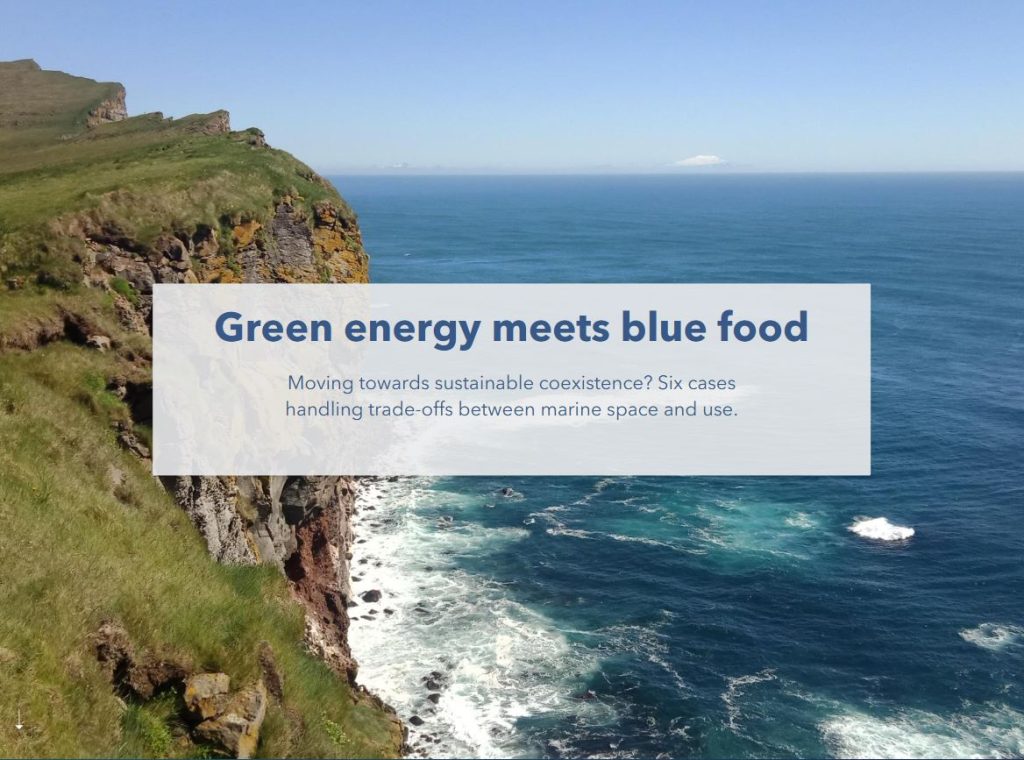Nordic countries have set up ambitious climate and energy targets and offshore renewable energy will play a key role in enabling the green transition in the Nordic Region. The European Green Deal underscores at the same time the importance of minimal harm to the environment and the contribution to nature conservation, with for example the EU Biodiversity strategy 2030 including more ambitious targets for protecting marine areas. Furthermore, our seas in the Nordic Region are also an increasingly important resource for food supply.
Offshore renewable energy, not least wind energy, is crucial for the green transition in the Nordic Region but its expansion poses challenges such as conflicts over space. Hence, there is an increasing need for enabling enhanced coexistence with other sectors, not least with blue food sectors such as fishing and aquaculture. Governance frameworks, in particular marine spatial planning, are crucial for managing conflicts, promoting collaboration, and for enabling possibilities for sustainable coexistence at sea.
The Nordic Council of Ministers have initiated several projects to address sustainable marine economy and coexistence issues. The “Green Meets Blue project”, financed by the Nordic Council of Ministers for Fisheries, Aquaculture, Agriculture, Food and Forestry (NCM FJLS) and running for two years (2024-2025), aims to contribute to a common knowledge base for the Nordic countries, by contributing with an increased understanding of sustainable coexistence between renewable energy (focusing on offshore wind energy) and marine food sectors (focusing on fisheries and aquaculture).
The project will give better insights on how Nordic countries can effectively tackle potential conflicts between the green and blue sectors, promote synergies and better enable cooperation and collaboration. The project seeks to investigate existing conditions on how trade-offs, conflicts and synergies are managed between these sectors within marine spatial planning frameworks from a governance perspective and in a Nordic context.
Questions the project will try to address are:
-How are coexistence conditions between offshore wind energy and marine food sectors described in existing research, including their interactions?
-How are conflicts and synergies between these sectors currently addressed in Nordic marine planning systems?
-How have conflicts and synergies been managed in different geographical settings in the Nordic region from a governance perspective, particularly in marine spatial planning?
-What lessons can be drawn from the experiences of different Nordic countries and regions regarding policy frameworks and governance mechanisms to handle conflicts and promote collaboration between offshore wind energy and marine food sectors in marine spatial planning?
We will conduct a thorough literature and policy review to identify trends, conflicts, and synergies, alongside defining key concepts and case study areas. Through case studies across varied geographical locations, the project examines governance practices related to managing the coexistence of offshore wind energy with marine food sectors. A series of workshops planned for 2025 aims to engage stakeholders from the Baltic Sea, North Sea, and North Atlantic regions, facilitating discussions on governance challenges and solutions for sector coexistence from local to cross-border levels. The project will disseminate its findings, through case study story maps, policy briefs and recommendations, to further improve the sustainable coexistence in Nordic seas.
Project outputs:

Case study storymap
Is it feasible for offshore renewable energy and marine food production to coexist sustainably in Nordic Seas? What drives and hinders actors in these sectors from collaborating? How are public processes supporting or hindering collaboration between these domains? Dive into this interactive storymap to explore the intricate complexities of coexistence through case studies across Finland, Sweden, Denmark, Norway, Iceland and Scotland here.

Participation at the Nordic Conference on Co-location of Marine Industries, 25-26 Sep 2024.
The conference aimed to bring Nordic stakeholders together and facilitate an exchange of ideas, with a focus on offshore renewable energy, fishing, and aquaculture. Its aim was to highlight opportunities and challenges with the increasing demand for sea space and promote nature-positive solutions for co-location. Nordregio researcher Kerstin Bly Joyce presented this research project. This report summarises the presentations from the conference along with the input from the attendees and provides suggestions for future work towards increased coexistence and co-location of marine industries. Read it here.





